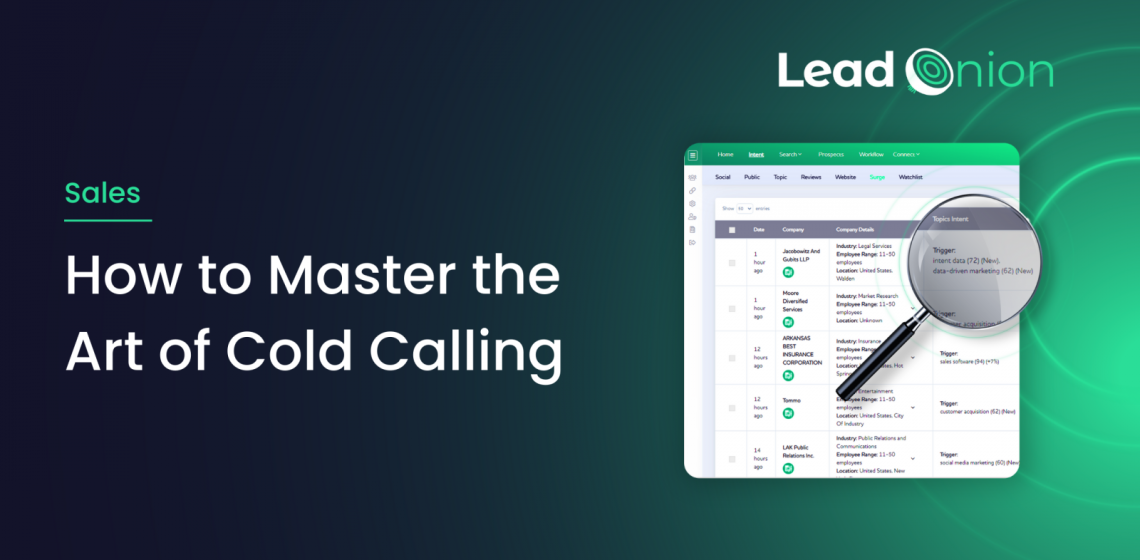Cold calling is an essential aspect of the sales process that requires thorough preparation, unshakable confidence, and a comprehensive understanding of your target audience.
As reported by The Rain Group, 82% of buyers welcome meetings with salespeople who have reached out to them cold. However, a mere 28% of salespeople find success in their cold outreach efforts. This stark contrast between success and failure in cold calling highlights the importance of preparation.
Lead Onion is revolutionizing the sales industry with its innovative approach to prospecting and lead generation. In this blog post, we shall discuss the key strategies and tactics that sales professionals can employ to master cold call preparation and elevate their sales success with Lead Onion.
Know Your Audience
To achieve success in cold calling, it is crucial to research and understand your target audience. Sales for Life reveals that salespeople who research their prospects before making calls are 70% more successful than those who don't.
There are several strategies for gathering information about prospects, including using social media, reading industry publications, and leveraging buyer intent data.
Buyer intent data helps salespeople identify prospects who are actively researching or engaging with content related to their products or services. This valuable information enables sales professionals to prioritize their outreach efforts and tailor their pitches based on the prospect's interests and level of engagement.
.png)
For example, LinkedIn remains an excellent tool for researching prospects' professional backgrounds, while buyer intent data further enhances the understanding of their current needs and interests, ultimately leading to more effective sales conversations.
By comprehending your prospect's unique needs and interests, sales professionals can tailor their pitch to their audience and develop strong rapport. Personalized outreach communicates to prospects that you've invested time in understanding their unique situation, increasing your chances of converting them into customers.
Craft Your Pitch
Another key aspect of successful cold calling is crafting a compelling sales pitch. Your pitch should include a clear value proposition and focus on the prospect's pain points. Research states that effective cold calls usually concentrate on the prospect's pain points in the first few minutes. By addressing these pain points, sales professionals can demonstrate that they understand the prospect's unique needs and have a solution to their problems.
By concentrating on the prospect's unique needs, the team can customize their pitch and create a strong connection with their prospects. Tailoring your pitch to different audiences is crucial.
Sales professionals should use industry-specific language and address specific concerns based on the prospect's role or company size.
Customizing your pitch to the individual prospect can help you stand out from the competition and establish a strong connection.
Get Your Opening Right
Once you have researched your target audience and crafted a compelling pitch, it is essential to ensure your opening is strong and engaging. The first few seconds of a cold call can make or break a conversation, as prospects will quickly decide whether to continue listening or hang up.
An effective way to start a cold call is by using a hook to capture the prospect's attention and spark their interest. This could be a thought-provoking question or an eye-opening statistic relating to their industry or business.
For example, if you're selling marketing software to a small businesses, you might begin by saying, “Were you aware that over 50% of small businesses don't have a website? How are you connecting with customers online?”
Another way to initiate a cold call is by building rapport with the prospect. This could involve identifying a mutual interest or shared experience, such as attending the same event or having a mutual connection. Breaking the ice in this manner can make the prospect feel more at ease speaking with you. It is also essential to respect the prospect's time and avoid sounding overly salesy or pushy. Focusing on providing value and building relationships can make a more positive impression. Offer a free resource or insight relevant to their business challenges or pain points.
Prepare for Objection Handling
Handling objections from prospects is a significant challenge in cold calling. Objections can range from “I'm not interested,” to “I don't have time right now,” or “I'm already using a similar product.” However, objections don't have to stop you. The right preparation and mindset can transform objections into opportunities to learn more about the prospect's needs and offer solutions addressing their concerns.
Firstly, anticipate common objections based on your target audience and product or service offering. This could involve researching industry trends or analyzing past sales conversations to identify recurring objections. With a list of potential objections in hand, you can develop responses that address each objection and provide value to the prospect.
Secondly, approach objections with positivity and a willingness to listen – see them as an opportunity to learn more about the prospect's needs and concerns. By actively listening and empathizing with their situation, you can establish trust and rapport that can lead to a successful sales conversation.
Nail Your Closing
After a successful cold call where you have built rapport and addressed concerns, it is crucial to close the conversation effectively. The right closing can lead to a commitment from the prospect, whether it's a follow-up call, a meeting, or even a sale.
However, a weak or awkward closing can leave a negative impression and hinder the sales process. One effective closing technique is the “assumptive close,” which involves assuming the prospect is ready for the next step and asking for their commitment. This approach conveys confidence and positions you as a solution provider, instead of a mere salesperson.
Build Confidence for Effective Cold Calling
Cold calling can be nerve-wracking, but several strategies can build confidence and reduce stress. Preparing for the call, practicing your pitch, role-playing with colleagues, and setting realistic expectations for success can help alleviate anxiety.
Remember, effective cold calling involves thorough preparation, unshakable confidence, and a comprehensive understanding of your target audience.
Why Lead Onion?
Companies looking to enhance their sales outreach and achieve better results should consider adopting Lead Onion for its comprehensive approach to lead generation, prospecting, and cold call preparation and actioning.
With Lead Onion, sales professionals can access vital buyer intent data, which offers invaluable insights into how prospects are engaging with content related to the products or services being offered. This data includes prospects' online interactions such as downloading whitepapers, attending webinars, or visiting product pages, essentially reflecting their current interests and potential readiness to make a purchase.
By leveraging this buyer intent data, sales professionals can prioritize their outreach efforts towards prospects who are actively seeking solutions and are more likely to be receptive to sales pitches. This targeted approach not only increases the efficiency of sales efforts but also improves the chances of successfully converting engaged prospects into customers.

Moreover, the insights provided by buyer intent data can help sales representatives tailor their pitches more effectively by addressing the specific pain points and interests of each prospect. In turn, this leads to more meaningful and engaging sales conversations, ultimately driving better sales results.
The platform's built-in call feature further streamlines the sales process, allowing salespeople to directly engage prospects from within the platform itself. This integrated approach not only saves time but also provides invaluable context for each call, ensuring that sales professionals can tailor their pitches to the unique needs and interests of their prospects.
By leveraging Lead Onion's innovative features, companies can drive higher engagement, stronger connections, and ultimately, more successful sales outcomes.
Conclusion
In conclusion, cold calling remains a vital aspect of the sales process, requiring thorough preparation, solid confidence, and deep understanding of the target audience. Lead Onion stands out as a powerful solution, revolutionizing the sales industry through its innovative approach in prospecting, lead generation, and cold call preparation.
By adopting Lead Onion, sales professionals can effectively prioritize their outreach, tailor their pitches, and significantly boost their success rates by leveraging buyer intent data and the platform's built-in call feature.
Ultimately, embracing Lead Onion's features and the strategies outlined in this blog post will lead to higher engagement, stronger connections, and superior sales results for your business.


.png)
